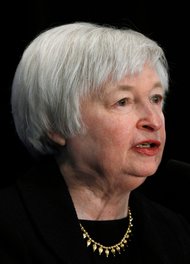 Gary Cameron/Reuters Janet Yellen, vice chairwoman of the Federal Reserve, shown at a conference in March, knows her way around a metaphor.
Gary Cameron/Reuters Janet Yellen, vice chairwoman of the Federal Reserve, shown at a conference in March, knows her way around a metaphor.
Janet Yellen likes metaphors. This is a common trait among central bankers, at least the ones who see value in trying to explain their work.
In 2007, she compared problems in the housing market to a 600-pound gorilla lurking in the corner of the Federal Reserve’s meeting room.
In 2010, she described the state of financial regulation before the crisis as “a financial Maginot Line that we believed couldn’t be breached.”
We all know what happened next: The gorilla broke through the Maginot Line.
She is not the most colorful of the current crop of Fed officials. That honor surely belongs to Richard Fisher, president of the Federal Reserve Bank of Dallas, whose most recent speech was titled “Oil and Gas, Blondes and Over-Accessorized Brunettes, and Ruthless, Hard-Drinking Cowboys.”
Nor has she ever produced anything quite as enduringly memorable as former Fed chairman William McChesney Martin’s famous description of central banking. The job, he said, is “to take away the punch bowl just as the party gets going.”
But Ms. Yellen, whom I profiled Thursday as a logical successor to Ben S. Bernanke, the Fed chairman, can paint a picture. Consider her description at the September 2007 meeting of the Fed’s policy-making group, the Federal Open Market Committee, of “the earthquake that began roiling financial markets in mid-July. Our contacts located at the epicenter — those, for example, in the private equity and mortgage markets — report utter devastation. Anecdotal reports from those nearby — for example, our contacts in banking, housing construction, and housing-related businesses — suggest significant damage from the temblor.”
In 1995, concerned that the Fed was keeping interest rates too high, she compared the effects to “a termites in the basement problem,” suggesting that the high rates would gradually weaken and undermine the vitality of the economy.
“A ‘termites in the basement’ problem is a nagging, chronic little problem that can eventually cause a lot of grief if it is not attended to,” Ms. Yellen said at the Fed’s September meeting, according to the Fed’s transcript. “Termites nibble away slowly so the problem just creeps up and there is no great sense of urgency that one absolutely has to deal with it on one day as opposed to the next.”
Other members of the committee then picked up on the metaphor, invoking termites to make their own case for lower interest rates.
And then there is my personal favorite. Earlier in 1995, the Fed was debating whether to endorse Congressional legislation directing the Fed to make price stability its sole objective, replacing the “dual mandate” that instructs the central bank to minimize both unemployment and inflation.
Ms. Yellen was one of the strongest voices in opposition, arguing repeatedly that the people wanted the central bank to mitigate economic downturns in addition to minimizing inflation, and that the central bank had the ability and therefore the responsibility to do so.
Even the German central bank, famous for its commitment to suppress inflation, sought to mitigate economic downturns, she said.
“Who would be prepared to believe that the F.O.M.C. is single-mindedly going to pursue an inflation target regardless of real economic performance, if not even the Bundesbank is prepared to go that far?” she said. “So, that means that the targets are going to be perceived as a hoax.”
And then, to drive the point home, she added, “They are not going to be any more believable than I would be if I told my child that I was going to cut off his hand if he put it in the candy drawer.”
Article source: http://economix.blogs.nytimes.com/2013/04/25/the-gorilla-and-the-maginot-line/?partner=rss&emc=rss
Speak Your Mind
You must be logged in to post a comment.